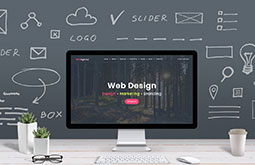5 Reasons Why Responsive Web Design is Important
Along with powerful functionalities, beautiful designs, and fast-loading pages, responsive web design has become another critical necessity for websites. It’s a fact that there are more mobile users than desktop users. That is why making a website design responsive is the best way to win over a large audience.
Responsive web design provides an optimal experience for users by allowing them easy reading and navigation. Besides, Google also ranks the mobile version of the websites more. So, it is very essential to have a mobile-friendly site to rank higher in Google. This led to the beginning of the responsive web design era.
In this article, we will discuss the 5 main reasons why web design is crucial to your business. But before we get into that, let us first understand its basics.

Responsive Web Design: The Concept
Have you opened the same site on your smartphone and laptop? If yes, you must have noticed that the site intuitively adapts to the size of screen and browser for clear and logical display. This is the example of responsive web design. The URL and source of site’s content remain the same. When a site is responsive, its layout becomes fluid which flexibly adjusts as per the size of user’s screen. The aesthetics of website is retained and your web browsing experience is optimized.
Static Web Design: The Concept
The websites of older days were of static design. At that time, you would only browse sites from your desktop or laptop. Hence, no other option was required. Once large screen cell phones with supportive OS started appearing on the scene, people started browsing sites on the go through mobiles and tablets.
Some properties of static design are:
- Dimensions of the website remains the same
- In every device, the site would appear in same size
- When static site is browsed from phone, the screen has to be swiped frequently
- Swiping allows user to view the complete content on page
- Site needs to be zoomed out to make the text legible
- User experience is not optimized
- The cost of building a static website is less
Responsive web design(RWD) was formulated to ensure that users can browse sites from mobile devices in optimum manner. Responsive sites don’t have fixed dimensions instead percentages define them. When the device from which the site is browsed changes, the website changes its percentage intuitively to adjust to screen size.
Migrating the Design of Website from Static to Responsive
RWD is no longer a luxury. It is a must for any brand that desires to remain relevant and popular. Each brand is looking for ways to make its site smartphone friendly because with dropping prices of mobiles and data charges, everyone has access to cellphones.Designers are keen to apply RWD because of
- Dynamic Serving
- Separate URLs
There is huge demand for converting static website to responsive because this makes even an older site browsable over mobile devices. RWD poses challenges to designers during development of new responsive website from scratch or during conversion from a static one. This can be attributed to the designers’ relative ignorance about proven ways to implement RWD.
Important Things to Factor in During Responsive Web Designing
Operating Systems (OS)
- Windows and Mac OSs on out computers and desktops
- iOS on Apple iPads, iPhones and similar devices
- Android from Google which is available in all non-Apple smartphones/ mobile devices
- BlackBerry OS which is now almost obsolete
- Symbian OS which is present in Nokia phones
- WebOS, now fully defunct
Since the number of OSs for mobile is comparatively more than desktop ones, developing mobile optimized sites becomes a challenge.
Web Browsers
- Safari from Apple for iOS
- Android in-built browser whose performance is good though it lags Safari
- Dolfin browser for Samsung phones
- Blackberry’s native webkit
- Opera Browser
- Google Chrome
- Palm Webkit
- Nokia Webkit which has poor support for javascript
- Firefox from Mozilla
The RWD has to be tested for all these browsers for optimum results. Since it serves no useful purpose to tinker with all browsers, it is sensible to concentrate on most popular ones only.
Size of Device Screen
Like standard desktop or laptop screen sizes, the size of smartphone screens is not fixed. They may vary between 320X240 pixels to 640X960. A single percentage value won’t match all screens. You can go through analytics data to arrive at the minimum value that you must maintain for RWD.
Density of Pixels
- In Apple’s retina display, pixels are very small
- For iOS, larger images should be used
- This would make backdrop pictures and icons appear visually pleasing
Process To Convert The Static Design of Website to Responsive
When you get down to converting an old website into a responsive one, you need to consider a number of facts for stellar results. These have been enumerated below.
- Analyze the code and design peculiarities of the old site
- Choose the number of layouts required for static site for various devices
- Each device on which site would be opened would have unique layout
- You should consider breakpoints first before planning different layouts
- Explore the present design to identify points where site elements undergo spontaneous break down
- Suitable breakpoints have to be decided based on present content of site
- Plan the way content should adjust to various screen sizes
- Plan how web pages would be rendered in full view in mobile devices
- Decide how to offer pinch to zoom in function to facilitate browsing of selected content
- Modify the zoom behavior appropriately for mobile browsers
- Ensure that responsive media queries should function properly
- With viewport tag, you can set the page view to any aspect ratio for any screen size
- Viewport tag can be used for instructing browser about using device width as viewport width
- CSS styles are defined by media queries in responsive design for any given device
- Style can be defined for attributes such as width of screen and resolution
- CSS styles can be set for varied layouts for various device sizes
- Properly implemented media queries are useful in delivering superior browsing experience
- Experience can be optimized for various devices seamlessly
- Analysis of layouts and breakpoints would allow you to choose perfect media queries for site
- Start with queries for smaller screens and gradually migrate to larger ones
- Intuitive and self-driven site navigation needs to be integrated in responsive design
- Off canvas or drop in menu is perfect for facilitating navigation in devices with smaller screens
- Responsive Typography allows fonts to be legible, readable and flexible on every device
- Using CSS elements like rem and em maintains readability across various devices
- Optimally size videos, images and other visual elements for maximum responsiveness
- Analyze which media size would be best for the converted website
- Strategize on serving correct media for device on which site is browsed
- Maintain a flexible layout for various responsive webdesign screen sizes
- Resolution of computer screens is high while that of mobile devices is low, so optimize media
- Ensure that each media element remains within the container
- Factor in various interaction types that your site would be subjected on various devices
- Understand that touch is the main input method for smartphones, tablets and high-end mobile devices
- Consider this while preparing site for handling different interaction types
- Steer clear of perception that interaction working perfectly on a device would be so for others also
- Be aware of the fundamental and practical differences of devices
- Make the website mouse/ keyboard as well as finger friendly also
By adhering to the aforesaid pointers, you would be able to design a fully functional site with responsive web design.
A website is something more than mere presence of your brand or business in the web. It in fact plays a pivotal role in marketing, interacting with clients and maintaining the overall brand image of a company. A large section of customers use mobile gadgets, tablets and other sophisticated devices to get access to the internet and this is where the importance of responsive web design lies in.
In order to capitalize on the optimum usage of infographics and other features, businesses nowadays increasingly incorporate responsive websites. Due to this, the users can experience various aesthetic and functional benefits. Every organization wants to strive in the competition with unique marketing strategies. It offers great degree of innovation and flexibility.
Why is Responsive Web Design Critical for Business?
Here are five reasons why responsive web design is important for business.
Great looks of website pull more customers
How a website looks matters a lot when it comes to marketing. People visiting a webpage are fascinated by innovative designs and pathbreaking features. It results in an attractive portal which generates more traffic. Besides, it is even compatible for mobile gadgets. Minute details on the website are visible on mobile phones. These websites are adaptable to all display sizes and hence, the company can reach out to a larger section of people. It is crucial for marketing and broadens the customer base of firms.
Responsive websites are equally compatible with desktops, laptops, smartphones, mobiles, or any other device. According to a statistic, 56% of the internet users in the US use mobile phones to get access to webpage. The figure is similar in other countries as well. Therefore, the web designers need to ensure enough flexibility to make them compatible to all possible platforms. And this is the important characteristic for the devices and screen sizes searchers will use to access your site.
Another important cause for popularity of responsive web design is that people are increasingly switching to mobile devices for online shopping. This virtual marketplace has to be easily accessible to all the users. Therefore, it is wise to design the website for mobile gadgets and responsive web design for business goes well with up-to date mobile phones.
Enhanced user experience (UX) improves the brand image
It is of prime importance to ensure seamless navigation of the websites. It enhances the overall user experience, which, in turn, leverages the brand image of respective companies. Responsive designs are easy to use. You would never want your website to look awkward to the users. Responsive websites do not show problems while scrolling or zooming. The users can handle the webpage and make relevant searches without any hassle. When they access from their mobile phones, they will enjoy equal benefits as the desktop users. And it provides better user experience for the visitors. Automatically it keeps your website engaged.
Websites on mobile devices take a long time to load sometimes, if the same version is available for both the desktop and mobile versions. When you incorporate responsive web designs done by an affordable website design company with proven expertise, you will not face these issues. You can deliver a far better experience to your customers, whether you own an eCommerce site or an ordinary one. They can enjoy all the features without any hitch when you incorporate responsive web designs. Also you must follow the proven tips to enhance the user experience while designing the website.
Mobile friendly website
Responsive web design is not only about compatible of screens and resizable images, but rather about a whole new approach to web design.
You must be aware of the immense benefits of search engine optimization. Well, a responsive website promotes SEO and in turn, you will enjoy better search engine rankings. First of all, these webpages take a shorter time to load. As much as 47% of the internet users expect webpage to load in just two seconds. In these cases, the time needed for your pages to load need to be considered. Slow websites frustrate the customers and they flee to other sites. Evidently, responsive designs are ideal for SEO purposes. In mobile devices, different elements of the page, including images are optimized and this enables the users to open the website much faster. It cuts down the time requirements and ensure a seamless experience to the users.
Secondly, Google algorithms support fast-loading websites, which means that fast-loading websites rank higher in the searches. When you opt for professional responsive web design services, you will get a fast-loading website, which would give you excellent SEO outcomes, thereby allowing your business to gain more visibility and witness growth. People accessing web through mobile devices are more likely to get a richer experience when they visit responsive websites, which are noted for their mobile-friendly features.
The ‘mobile first’ philosophy of Google complements this strategy and you can immensely benefit from responsive designs. Particularly, when your customers go for local searches, these designs are more effective for mobile users. And understand the recommendation of Google; and make a mobile friendliness site, which improves ranking in search engine results.
Promote social media marketing
Brands from different industries are opting for social media marketing. In these cases, they expect a classy set-up to get across to their clients. So, if you want to conduct a balanced social media campaign, you need to have a responsive webpage.
It is possible to incorporate all the design principles that make a webpage effective in responsive websites. A reliable statistic reveals that nearly 80% of social media users use mobile gadgets for internet access. Therefore, you need to opt only for responsive web designing and development services for availing the benefits.
For instance, if you share links to your website on social media platforms like Facebook, Instagram, Twitter, and other sites, chances are high that people will open the links and know about your products and service.
-
Cost-effective and easy to maintain
Creating a separate site for mobile users can get a little expensive. Besides, you need to pay extra attention to its maintenance.
It means you need to give time to updating and refreshing both your desktop and mobile websites. Making changes won’t be even easier or quicker. Besides, you may even have to hire another designer to handle both the website versions.
However, when you use a responsive web design, you can save money on creating a separate mobile website. Also, you do not have to hire separate designers for maintenance. It might be a little expensive in the beginning but will pay off better in the long run.
Conclusion
Well, people often browse the social media pages at their leisure hours. Therefore, you need to keep the users engaged with recent graphic design trends for webpages through social media pages. Certain customers do not prefer opening official pages of websites through desktops. Rather, they opt for mobile gadgets and social media sites to access these portals. Thus, it is essential for a successful social media campaign.




